In a significant address to the nation on Sunday, September 21, 2025, Prime Minister Narendra Modi announced a sweeping overhaul of the Goods and Services Tax (GST) regime, set to come into effect from September 22, 2025. Dubbed ‘Next Generation GST reforms’ and a ‘GST Bachat Utsav’ (Savings Festival), these changes aim to simplify the tax structure, reduce prices on approximately 375 items, boost domestic consumption, and significantly accelerate India’s economic growth trajectory.
A Simplified Tax Landscape Takes Hold
The core of the reform, approved by the GST Council comprising central and state governments, involves a transition from the existing four-tier tax structure (5%, 12%, 18%, and 28%) to a predominantly two-tier system of 5% and 18%. A special rate of 40% will apply to select luxury and ‘sin’ goods, while some essential items may be fully exempted. This rationalisation is expected to bring a wide array of goods and services within easier reach of the common citizen. Notably, nearly 99% of items previously falling under the 12% tax slab will now be taxed at 5%, and approximately 90% of goods from the 28% slab will shift to the 18% bracket. This strategic move is designed to infuse approximately ₹2.5 lakh crore into the economy when combined with earlier income tax relief measures, creating a “double bonanza” for citizens.
Fueling Consumption and Economic Momentum
Prime Minister Modi expressed strong confidence that these GST reforms would significantly accelerate India’s growth story, enhance the ease of doing business, and make investment more attractive. The reduction in tax rates on daily essentials such as ghee, paneer, butter, packaged foods, medicines, and personal care items, alongside aspirational goods like televisions, air conditioners, and washing machines, is projected to directly increase household disposable income. Experts and analysts anticipate a substantial boost to consumption demand, with estimates ranging from ₹70,000 crore to ₹1 trillion, potentially adding 0.5% to 1.6% to the national GDP growth. This calculated move, detailed in trending economic news, is seen as a strategic stimulus for domestic demand amid global economic uncertainties.
Boosting ‘Swadeshi’ and ‘Atmanirbhar Bharat’
In conjunction with the tax reforms, Prime Minister Modi reiterated his call for citizens to embrace ‘Made in India’ (Swadeshi) products. He emphasized that the prosperity of India is intrinsically linked to its indigenous manufacturing base and urged citizens to take pride in supporting local industries. This push for self-reliance, or ‘Atmanirbhar Bharat,’ is seen as a long-term strategy to build a more resilient and competitive economy. The reforms are also expected to provide significant relief to sectors like construction, with tax cuts on cement and other materials, aligning with national missions such as ‘Housing for All’ and ‘Smart Cities’.
Background and Broader Vision
The Goods and Services Tax (GST) was first implemented in India on July 1, 2017, as a monumental indirect tax reform to unify multiple central and state taxes into a single system, aiming for ‘One Nation, One Tax’. This latest ‘GST 2.0’ represents a significant evolution, simplifying compliance, reducing tax disputes, and fostering a more transparent tax ecosystem. Finance Minister Nirmala Sitharaman highlighted that the government considered five essential criteria before implementing these changes, focusing on relief for the poor and middle class, meeting aspirations, supporting farmers, benefiting MSMEs, and boosting employment-generating sectors.
Looking Ahead
While the reforms have been widely welcomed, some opposition parties have criticized the Prime Minister for claiming sole ownership of the amendments. However, the overarching sentiment from government and industry stakeholders is optimistic. The simplified tax structure, coupled with a reduced compliance burden, is expected to drive industrial growth, attract greater investment, and position India as a competitive and stable production base in the global landscape. The ‘Next Generation GST reforms’ are not merely fiscal adjustments but a structural enhancement aimed at powering India’s inclusive growth and reinforcing its position as one of the world’s fastest-growing major economies.




